
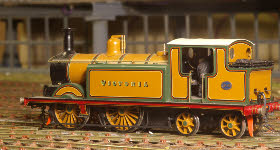

MORE ON DESIGN CONCEPTS
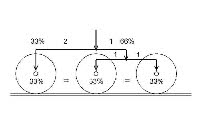 I think one of the big issues, particularly for small locos, is getting the weight distribution reasonably well balanced. For an all-
I think one of the big issues, particularly for small locos, is getting the weight distribution reasonably well balanced. For an all-coupled loco, an 0-6-0 for example, that may not be especially important, since all the weight is available for traction, but it becomes increasingly important as the number of driven axles reduces. Figure 2a shows how the weight is distributed equally on all wheels if 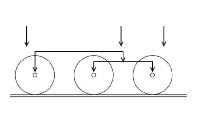 the centre of gravity is in the middle of the wheel base. For practical reasons, weight will be added to the loco wherever it can be fitted -
the centre of gravity is in the middle of the wheel base. For practical reasons, weight will be added to the loco wherever it can be fitted - boiler, side tanks, bunker, etc, so it’s not at all obvious where the CoG actually is, as shown in figure 2b.
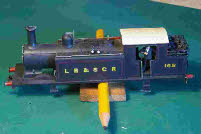 Moving the CoG forwards or backwards will change the weight distribution, and this can be calculated if you have a little knowledge of levers from your school physics lessons. An approximate way of finding the CoG is shown in figure 2c -
Moving the CoG forwards or backwards will change the weight distribution, and this can be calculated if you have a little knowledge of levers from your school physics lessons. An approximate way of finding the CoG is shown in figure 2c - balance the loco on a pencil, and the balance point is under the CoG.
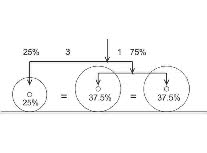 By deliberately moving the centre of gravity forwards
By deliberately moving the centre of gravity forwards 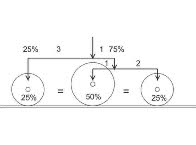 on an 0-
on an 0-4-2 for example, more weight can be applied to the driving wheels, and again, with a little arithmetic the weight distribution can be determined as in figure 2d. As well as moving the CoG, it is possible to alter the pivot points of the various beams to change the weight distribution. Figure 2e shows how this can benefit a 2-2-2.
In conclusion on the relative merits of springs vs compensation, I think compensation has benefits:
- control over weight distribution
- better traction
- better electrical pick-up
- and easier to build
Others of course have different views!
 I think one of the big issues, particularly for small locos, is getting the weight distribution reasonably well balanced. For an all-
I think one of the big issues, particularly for small locos, is getting the weight distribution reasonably well balanced. For an all- the centre of gravity is in the middle of the wheel base. For practical reasons, weight will be added to the loco wherever it can be fitted -
the centre of gravity is in the middle of the wheel base. For practical reasons, weight will be added to the loco wherever it can be fitted - Moving the CoG forwards or backwards will change the weight distribution, and this can be calculated if you have a little knowledge of levers from your school physics lessons. An approximate way of finding the CoG is shown in figure 2c -
Moving the CoG forwards or backwards will change the weight distribution, and this can be calculated if you have a little knowledge of levers from your school physics lessons. An approximate way of finding the CoG is shown in figure 2c - By deliberately moving the centre of gravity forwards
By deliberately moving the centre of gravity forwards  on an 0-
on an 0-In conclusion on the relative merits of springs vs compensation, I think compensation has benefits:
-
Others of course have different views!
Figure 2a
Figure 2b
Figure 2c
Figure 2d
Figure 2e